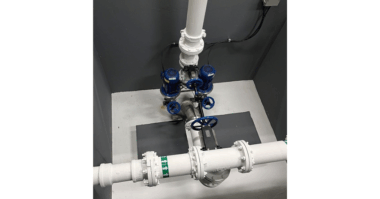The May 2013 deadline for compliance with the emissions regulations known as RICE NESHAP is fast approaching, and operators of large diesel engines are facing difficult challenges in finding a reliable partner to design and install a system that will put them in compliance and avoid large fines (in typical bureaucratic fashion, the EPA’s acronym is dense; it stands for Reciprocating Internal Combustion Engines – National Emission Standards for Hazardous Air Pollutants).
A leading diesel OEM has filled this void. Over the last several years, Fairbanks Morse Engine has installed numerous emissions systems to help engine operators keep the EPA at bay. One such example is the municipal power plant at Two Harbors, Minnesota. While they do not drive pumps with their diesels, the emissions issues they face are the same.
The Two Harbors plant relies on a Fairbanks Morse 38TDD8 1/8 Opposed Piston engine rated at 2 megawatts at 720 RPM. Plant managers wisely sought out a “turnkey” provider for their new emissions equipment, thereby insuring that their engines continue to operate effectively while still protecting the environment.
Fairbanks Morse installed an Enviro Design exhaust treatment system consisting of a diesel oxidation catalyst (DOC), a silencer with temperature and pressure monitors, and a crankcase ventilation system (CCV). Together they work to reduce CO emissions from the Fairbanks Morse engine by 93% while running on diesel fuel (the engine can also operate on a dual-fuel mix of natural gas and diesel pilot, with corresponding CO reductions of 95%).
The Environmental Protection Agency’s RICE NESHAP standards call for drastically reducing crankcase emissions as well as exhaust emissions for engines over 300 hp. The Two Harbors plant chose a custom-designed CCV that mounts next to the engine on the facility’s interior wall. It relies on a coalescing filter to capture hazardous particulates and vented oil mist. For oil recovery, the CCV also includes an integrated drain.
Once installed, the engine was started and run at full load while measurements were taken. They revealed the CCV was operating as designed and all pertinent requirements were met.
The Two Harbors team met their RICE NESHAP requirements with many months to spare, but they are undoubtedly the exception in this regard. Many engine owners are still scrambling to understand the new regulations and hurriedly comply by the May 2013 deadline. Still others are crossing their fingers that political winds will change and the EPA’s rules will be altered.
This is a risky proposition. Diesel-driven pump operators are wise to find a partner who can both interpret the regulations as they apply to their particular installation while protecting the significant investment in their diesels. And do it in a timely fashion – May 2013 is just around the corner.
Fairbanks Morse has more details here: http://www.fairbanksmorse.com/riceneshap
For more information on RICE NESHAP, visit: http://www.epa.gov/ttn/atw/rice/ricepg.html





